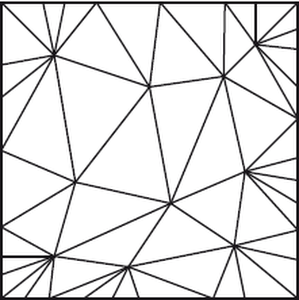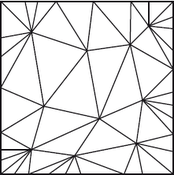Information
- Publication Type: Master Thesis
- Workgroup(s)/Project(s):
- Date: April 2008
- First Supervisor:
Abstract
Terrain rendering has a wide range of applications. It is used in cartography and landscape
planning as well as in the entertainment sector. Applications that have to render large terrain
are facing the challenge of handling a vast amount of source data. The size of such terrain
data exceeds the capabilities of current PCs by far.
In this work an improved terrain rendering technique is introduced. It allows the rendering
of surfaces with an arbitrary basis like the spherical-shaped earth. Our algorithm extends
the Geometry Clipmaps algorithm, a technique that allows to render very large terrain data
without losing performance. This algorithm was developed by Losasso and Hoppe in 2004.
Asirvatham and Hoppe improved this algorithm in 2005 by increasing the utilization of modern
graphics hardware. Nevertheless both algorithms lack of the ability to render large curved
surfaces.
Our application overcomes this restriction by using a texture holding 3D points instead of
a heightmap. This enables our implementation to render terrain that resides on an arbitrary
basis. The created mesh is not bound by a regular grid mesh that can only be altered in
z-direction. The drawback of this change of the original geometry clipmap algorithm is the
introduction of a precision problem that restricts the algorithm to render only a limited area.
This problem is handled by patching the whole surface with individual acting, geometry
clipmap quads.
Additional Files and Images
Additional images and videos
Additional files
Weblinks
No further information available.
BibTeX
@mastersthesis{fruehstueck-2008-gpu,
title = "GPU based Clipmaps",
author = "Anton Fr\"{u}hst\"{u}ck",
year = "2008",
abstract = "Terrain rendering has a wide range of applications. It is
used in cartography and landscape planning as well as in the
entertainment sector. Applications that have to render large
terrain are facing the challenge of handling a vast amount
of source data. The size of such terrain data exceeds the
capabilities of current PCs by far. In this work an improved
terrain rendering technique is introduced. It allows the
rendering of surfaces with an arbitrary basis like the
spherical-shaped earth. Our algorithm extends the Geometry
Clipmaps algorithm, a technique that allows to render very
large terrain data without losing performance. This
algorithm was developed by Losasso and Hoppe in 2004.
Asirvatham and Hoppe improved this algorithm in 2005 by
increasing the utilization of modern graphics hardware.
Nevertheless both algorithms lack of the ability to render
large curved surfaces. Our application overcomes this
restriction by using a texture holding 3D points instead of
a heightmap. This enables our implementation to render
terrain that resides on an arbitrary basis. The created mesh
is not bound by a regular grid mesh that can only be altered
in z-direction. The drawback of this change of the original
geometry clipmap algorithm is the introduction of a
precision problem that restricts the algorithm to render
only a limited area. This problem is handled by patching the
whole surface with individual acting, geometry clipmap
quads.",
month = apr,
address = "Favoritenstrasse 9-11/E193-02, A-1040 Vienna, Austria",
school = "Institute of Computer Graphics and Algorithms, Vienna
University of Technology ",
URL = "https://www.cg.tuwien.ac.at/research/publications/2008/fruehstueck-2008-gpu/",
}

 image
image paper
paper

